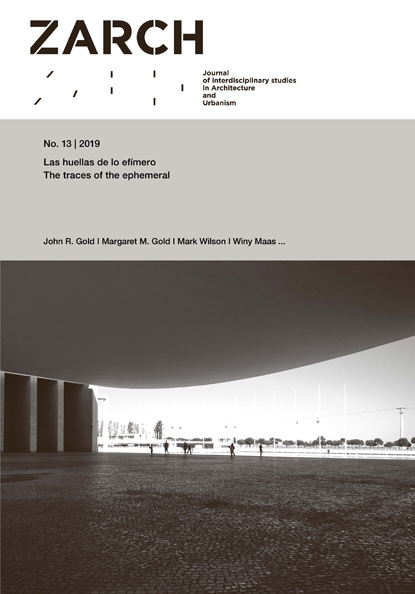On the importance of materials in the Monegros colonisation settlements
DOI:
https://doi.org/10.26754/ojs_zarch/zarch.2019133919Keywords:
Monegros, Colonisation settlements, Historical site, Modernity and tradition, Conservation and interventionAbstract
Two central elements converge in the heritage values of Spain’s colonisation settlements in general and of those in the Los Monegros region in particular: the notion of the single unit and the fusion of modernity and tradition. Materials play an important role in both aspects. This analysis seeks to identify the values in the original projects that are essential in order to recognise colonisation settlements as examples of architectural and urban heritage. The premise of this analysis is that the materials used to build these towns and villages have inherent value and, as such, must be maintained and conserved.
This paper forms part of a larger research framework, a doctoral thesis currently underway, in which the present conditions, degree of conservation and causes of deterioration observed in the colonisation settlements of Los Monegros are being analysed. After a series of general reflections on the architectural heritage of the materials, and after subsequent study of their current condition of the materials, guidelines are proposed for the improvement of their conservation. A series of possible criteria are also set out that can serve as a guide for any interventions to be made to the architectural heritage of these settlements, which are part of the overall history of Spain’s agrarian colonisation project.
Downloads
References
Baranguán, Paloma. 1998. Poblados de colonización: tradición y modernidad vivienda: técnica y lenguaje de fachadas. In VV AA Actas del Congreso Internacional “De Roma a Nueva York: itinerarios de la nueva arquitectura española 1950-1965”, 141-153. Pamplona: T6 Ediciones. Pamplona, October 1998.
Calzada Pérez, Manuel, coord. 2006. Pueblos de colonización I: Guadalquivir y cuenca mediterránea sur. Córdoba: Fundación Arquitectura Contemporánea.
_____, coord. 2007. Pueblos de colonización II: Guadiana y Tajo. Córdoba: Fundación Arquitectura Contemporánea.
_____, coord. 2008. Pueblos de colonización III: Ebro, Duero Norte y Levante. Córdoba: Fundación Arquitectura Contemporánea.
Centellas Soler, Miguel. 2010. Los pueblos de colonización de Fernández del Amo. Arte, arquitectura y urbanismo. Barcelona: Fundación Caja de Arquitectos.
Delgado Orusco, Eduardo. 2013. Imagen y Memoria. Fondos del archivo fotográfico del Instituto Nacional de Colonización (1939-1973). Madrid: Ministerio de Agricultura, Alimentación y Medio Ambiente.
______. 2015. Zona regable regional del Ebro. Vol.2 of El agua educada. Imágenes del archivo fotográfico del Instituto Nacional de Colonización (1939-1973). Madrid: Ministerio de Agricultura, Alimentación y Medio Ambiente. DVD.
Fernández Naranjo, Juan Antonio. 2005. La protección de los pueblos de colonización. PH Boletín del Instituto Andaluz de Patrimonio Histórico 52 (February): 89-92.
Luque Ceballos, Isabel; Guerrero Quintero, Carmen; Pérez Escolano, Víctor; Calzada Pérez, Manuel, coords. 2008. Pueblos de colonización durante el franquismo: la arquitectura en la modernización del territorio rural, Sevilla: Junta de Andalucía, Consejería de Cultura, Instituto Andaluz del Patrimonio Histórico.
Monclús Fraga, Javier y Juan Luis Oyón Bañales. 1988. Historia y Evolución de la Colonización Agraria en España. Volumen 1: Políticas y técnicas en la ordenación del espacio rural. Madrid: Secretaría General Técnica (MAPA), Instituto de Estudios de Administración Local (MAP), Instituto de Reforma y Desarrollo Agrario (MAPA), Instituto de Territorio y Urbanismo (MOPU) y Dirección General para la Vivienda y Arquitectura (MOPU).
Pallasmaa, Juhani. 2006. Los ojos de la piel. Barcelona: Gustavo Gili.
Pérez Escolano, Víctor. 2005. Pueblos de colonización franquista: objetivo patrimonial. PH Boletín del Instituto Andaluz del Patrimonio Histórico 52 (February): 38-42.
Villanueva Paredes, Alfredo and Leal Maldonado, Jesús. 1990. La planificación del regadío y los pueblos de colonización, Madrid: Ministerio de Agricultura, Pesca y Alimentación, Ministerio de Obras Públicas y Urbanismo e Instituto Nacional de Administración Pública (Colección Historia y evolución de la colonización agraria en España, vol. III).


